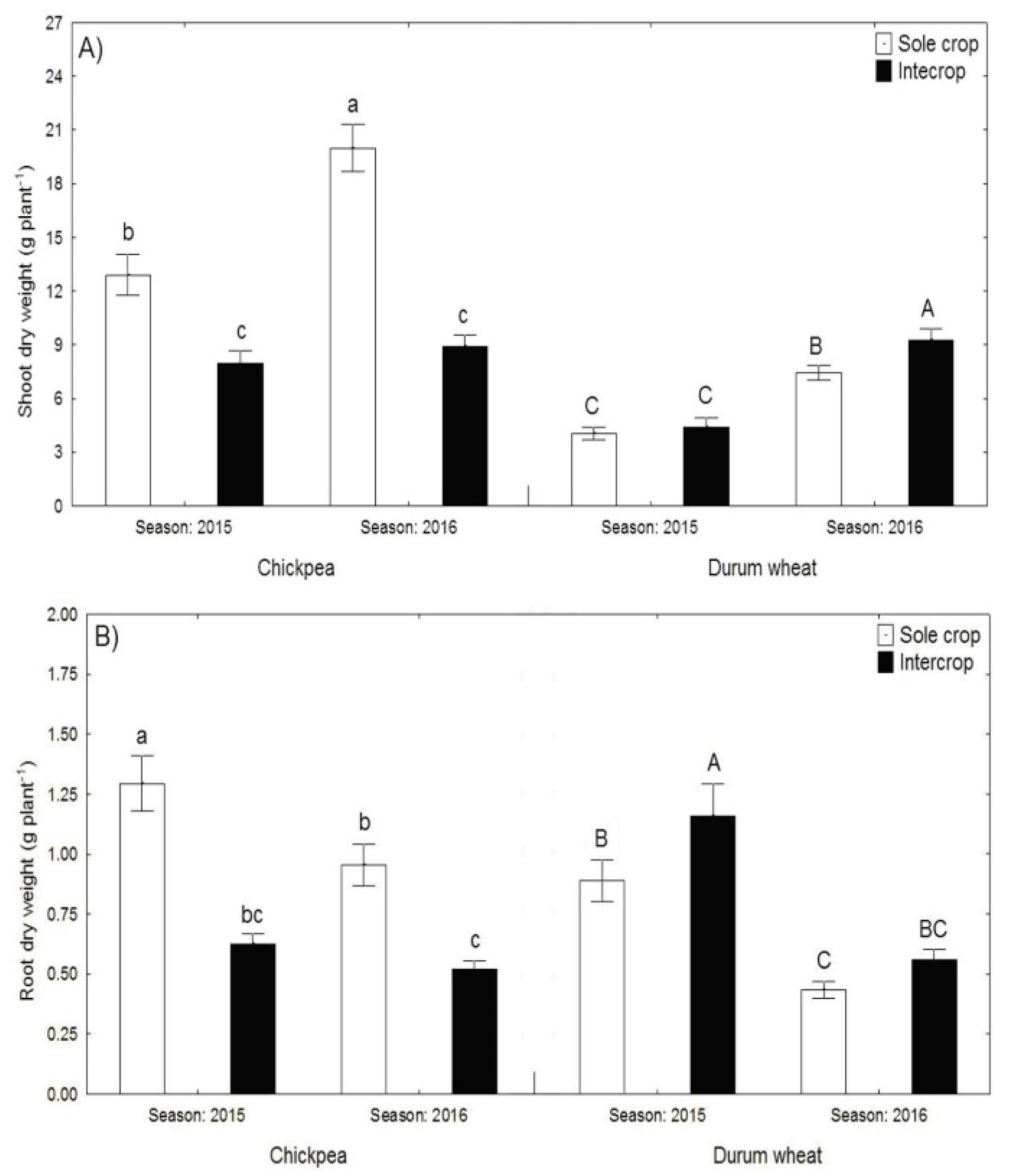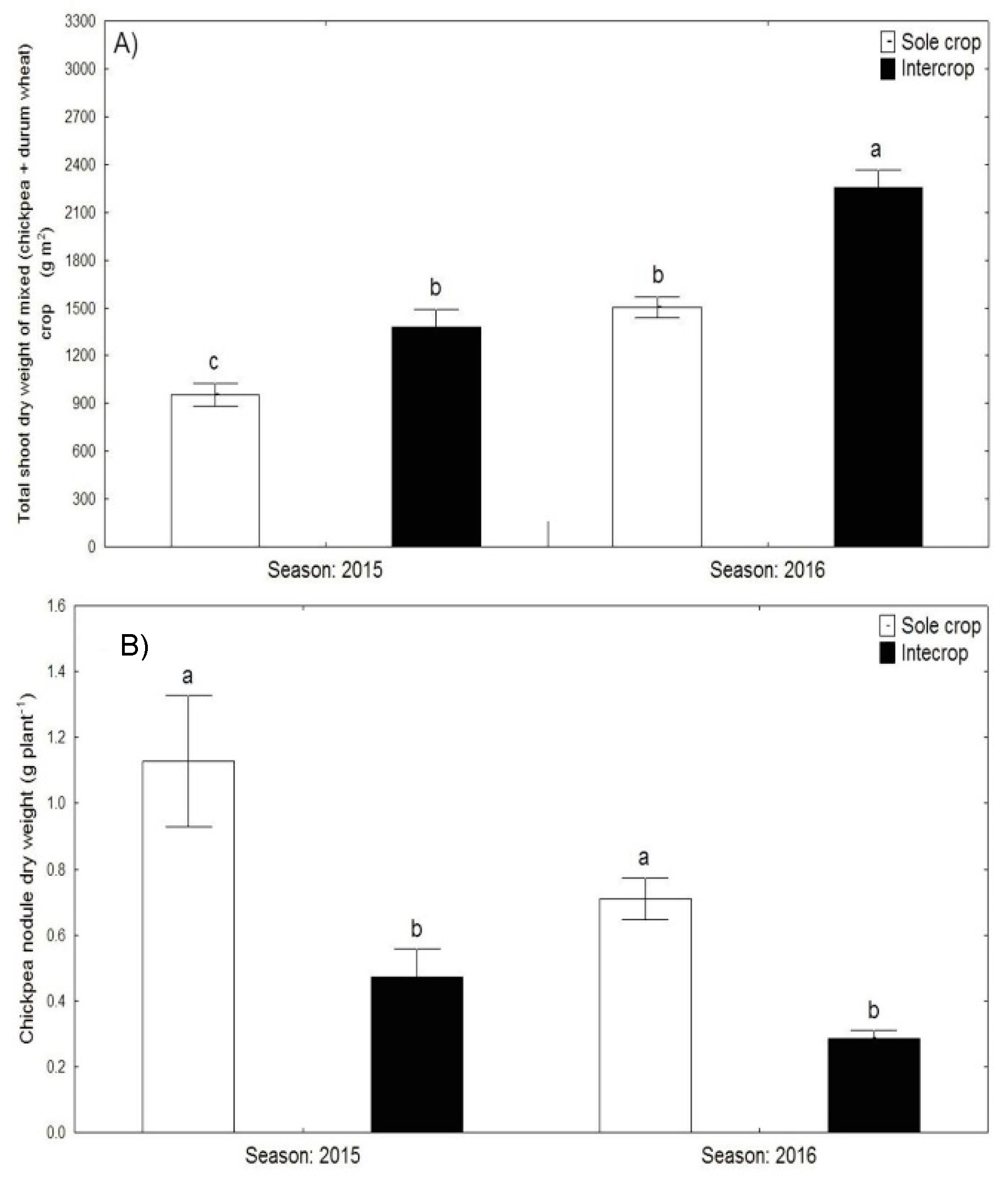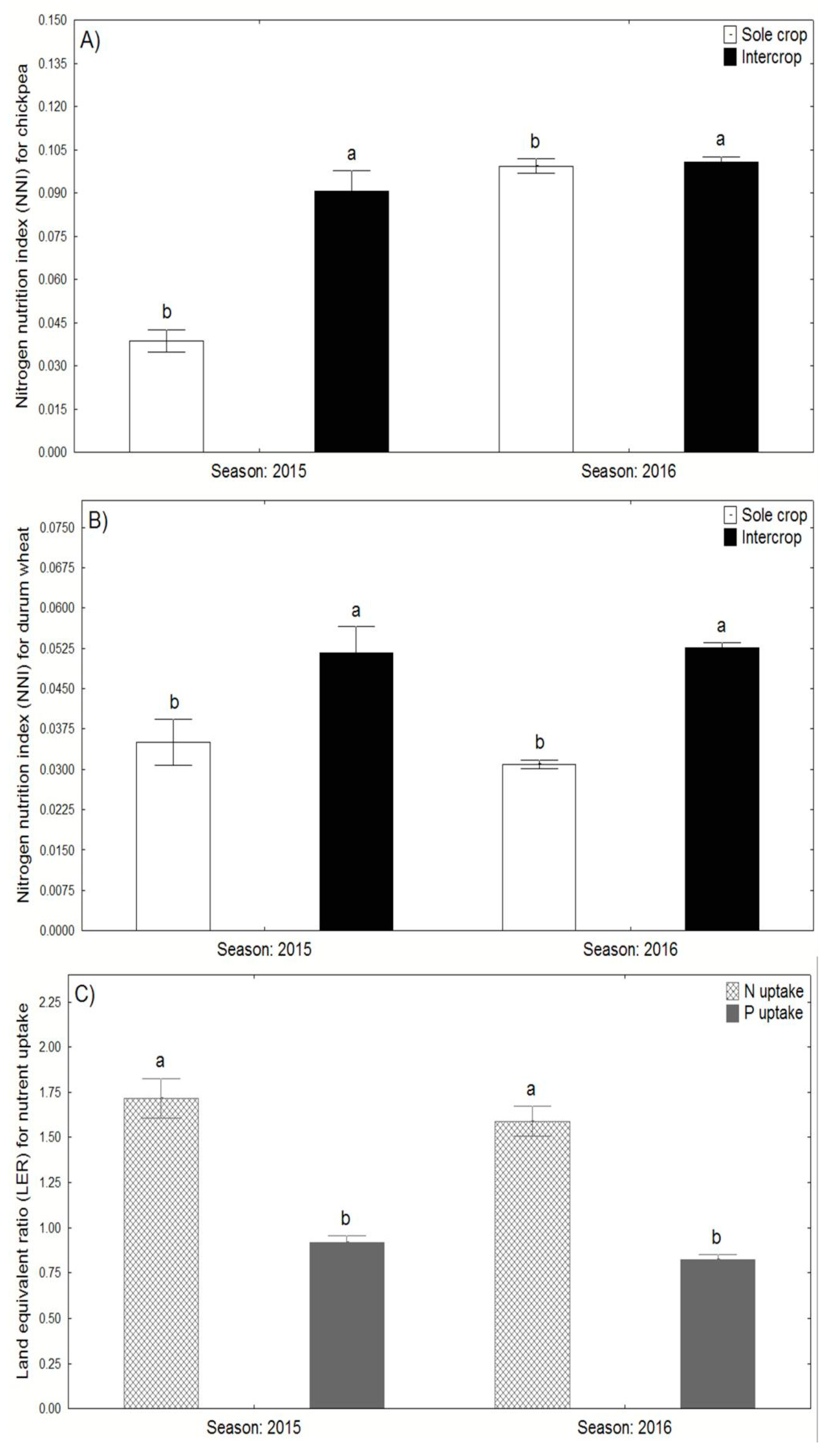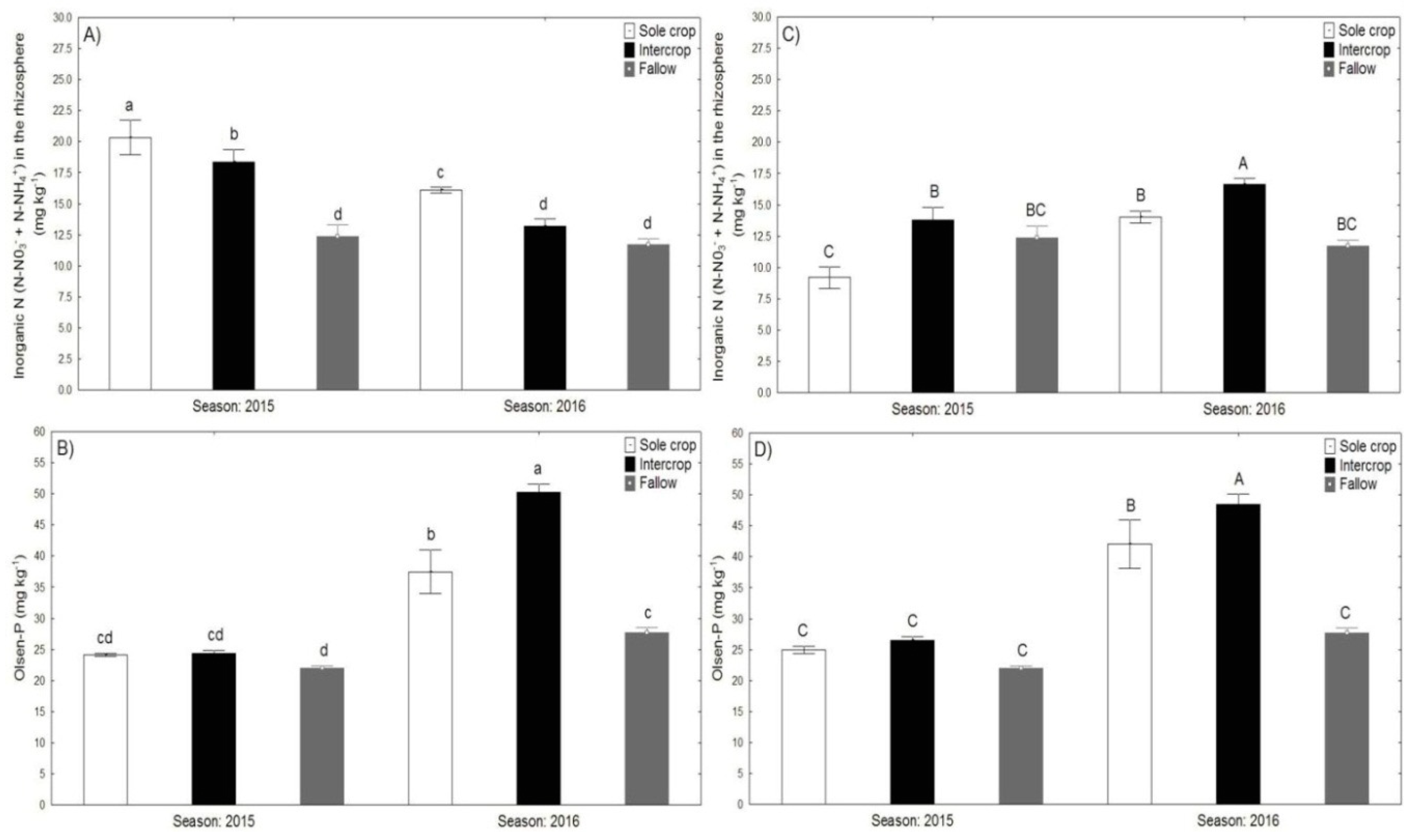Species Interactions Improve Above-Ground Biomass and Land Use Efficiency in Intercropped Wheat and Chickpea under Low Soil Inputs
Abstract
:1. Introduction
2. Materials and Methods
2.1. Experimental Site
2.2. Cropping and Field Plot Design
2.3. Plant and Soil Sampling and Measurements
2.4. Calculation
2.5. Statistical Analysis
3. Results
3.1. Plant Growth and Nodulation
3.2. Total Biomass, Grain Yield, and Land Equivalent Ratio (LER)
3.3. Symbiosis Performance for Plant Growth
3.4. Plant N and P Uptake by Species
3.5. Nitrogen Index Nutrition (NNI) and LER for N and P Uptake
3.6. Rhizosphere P and N Availability
4. Discussion
5. Conclusions
Supplementary Materials
Author Contributions
Funding
Acknowledgments
Conflicts of Interest
References
- Lemaire, G.; Meynard, J.M. Use of the nitrogen nutrition index for analysis of agronomical data. In Diagnosis on the Nitrogen Status in Crops; Lemaire, G., Ed.; Springer: Heidelberg, Germany, 1997; pp. 45–55. [Google Scholar]
- Dawson, C.J.; Hilton, J. Fertiliser availability in a resource-limited world: Production and recycling of nitrogen and phosphorus. Food Policy 2011, 36, 14–22. [Google Scholar] [CrossRef]
- Latati, M.; Benlahrech, S.; Lazali, M.; Tellah, S.; Kaci, G.; Takouachet, R.; Alkama, N.; Hamdani, F.Z.; Hafnaoui, E.A.; Belarbi, B.; et al. Intercropping promotes the ability of legume and ccereal to facilitate phosphorus and nitrogen acquisition through root- induced processes. In Grain Legumes; Goyal, A.K., Ed.; E-Publishing Intech: Rijeka, Croitia, 2016; pp. 127–139. [Google Scholar] [CrossRef]
- Lambers, H.; Shane, M.W.; Cramer, M.D.; Pearse, S.; Veneklaas, E. Root structure and functioning for efficient acquisition of phosphorus: Matching morphological and physiological traits. Ann. Bot. 2006, 98, 693–713. [Google Scholar] [CrossRef] [PubMed]
- Latati, M.; Pansu, M.; Drevon, J.J.; Ounane, S.M. Advantage of Intercropping Maize (Zea mays L.) and Common Bean (Phaseolus vulgaris L.) on Yield and Nitrogen Uptake in Northeast Algeria. IJRAS 2013, 1, 1–7. [Google Scholar]
- Naudin, C.; Corre-Hellou, G.; Pineau, S.; Crozat, Y.; Jeuffroy, M.H. The effect of various dynamics of N availability on winter pea–wheat intercrops: Crop growth, N partitioning and symbiotic N2 fixation. Field Crop Res. 2010, 119, 2–11. [Google Scholar] [CrossRef]
- Bedoussac, L.; Journet, E.-P.; Hauggaard-Nielsen, H.; Naudin, C.; Corre-Hellou, G.; Jensen, E.S.; Justes, E. Ecological principles underlying the increase of productivity achieved by cereal-grain legumes in organic farming. Agron. Sustain. Dev. 2015, 35, 911–935. [Google Scholar] [CrossRef]
- Hinsinger, P.; Betencourt, E.; Bernard, L.; Brauman, A.; Plassard, C.; Shen, J.; Tang, X.; Zhang, F. P for two sharing a scarce resource soil phosphorus acquisition in the rhizosphere of intercropped species. Plant Physiol. 2011, 156, 1078–1086. [Google Scholar] [CrossRef]
- Betencourt, E.; Duputel, M.; Colomb, B.; Desclaux, D.; Hinsinger, P. Intercropping promotes the ability of durum wheat and chickpea to increase rhizosphere phosphorus availability in a low P soil. Soil Biol. Biochem. 2012, 46, 21–33. [Google Scholar] [CrossRef]
- Latati, M.; Bargaz, A.; Belarbi, B.; Lazali, M.; Benlahrech, S.; Tellah, S.; Kaci, G.; Drevon, J.J.; Ounane, S.M. The intercropping common bean with maize improves the rhizobial efficiency, resource use and grain yield under low phosphorus availability. Eur. J. Agron. 2016, 72, 80–90. [Google Scholar] [CrossRef]
- Brooker, R.W.; Bennett, A.E.; Cong, W.F.; Daniell, T.J.; George, T.S.; Hallett, P.D.; Hawes, C.; Iannetta, P.P.M.; Jones, H.J.; Karley, A.J.; et al. Improving intercropping: A synthesis of research in agronomy, plantphysiology and ecology. New Phytol. 2014, 206, 107–117. [Google Scholar] [CrossRef]
- Latati, M.; Blavet, D.; Alkama, N.; Laoufi, H.; Drevon, J.J.; Gérard, F.; Pansu, M.; Ounane, S.M. The intercropping cowpea-maize improves soil phosphorus availability and maize yields in an alkaline soil. Plant Soil 2014, 85, 181–191. [Google Scholar] [CrossRef]
- Li, H.; Shen, J.; Zhang, F.; Clairotte, M.; Drevon, J.J.; Le Cadre, E.; Hinsinger, P. Dynamics of phosphorus fractions in the rhizosphere of common bean (Phaseolus vulgaris L.) and durum wheat (Triticumturgidum durum L.) grown in monocropping and intercropping systems. Plant Soil 2008, 312, 139–150. [Google Scholar] [CrossRef]
- Devau, N.; Le Cadre, E.; Hinsinger, P.; Gérard, F. Effects of inorganic fertilization and pH on processes and mechanisms controlling dissolved inorganic phosphorus in soils. Geochim. Cosmochim. Acta 2011, 75, 2980–2996. [Google Scholar] [CrossRef]
- Alkama, N.; Bolou Bi Bolou, E.; Vailhe, H.; Roger, L.; Ounane, S.M.; Drevon, J.J. Genotypic variability in P use efficiency for symbiotic nitrogen fixation is associated with variation of proton efflux in cowpea rhizosphere. Soil Biol. Biochem. 2009, 41, 1814–1823. [Google Scholar] [CrossRef]
- Alkama, N.; Ounane, G.; Drevon, J.J. Is genotypic variation of H+ efflux under P deficiency linked with nodulated-root respiration of N2-fixing common-bean (Phaseolus vulgaris L.)? J. Plant Physiol. 2012, 169, 1084–1089. [Google Scholar] [CrossRef] [PubMed]
- Latati, M.; Aouiche, A.; Tellah, S.; Laribi, A.; Benlahrech, S.; Kaci, G.; Ouarem, F.; Ounane, S.M. Intercropping maize and common bean enhances microbial carbon and nitrogen availability in low phosphorus soil under Mediterranean conditions. Eur. J. Soil Biol. 2017, 80, 9–18. [Google Scholar] [CrossRef]
- Lynch, J.M.; Barbano, D.M. Kjeldahl nitrogen analysis as a reference method for protein determination in dairy products. J. AOAC Int. 1999, 82, 1389–1398. [Google Scholar]
- Houassine, D.; Latati, M.; Rebouh, Y.N.; Gerard, F. Phosphorus acquisition processes in the field: Study of faba bean cultivated on calcareous soils in Algeria. Arch. Agron. Soil Sci. 2019. [Google Scholar] [CrossRef]
- Shen, A.L.; Li, X.Y.; Kanamori, T.; Arao, T. Effect of long-term application of compost on some chemical properties of wheat rhizosphere and non-rhizosphere soils. Pedosphere 1996, 6, 355–363. [Google Scholar]
- Leo, M.W.M. Determination of soil carbonates by a rapidegasometric method. J. Agric. Food Chem. 1963, 11, 452–455. [Google Scholar] [CrossRef]
- Hauggaard-Nielsen, H.; Ambus, P.; Jensen, E.S. Temporal and spatial distribution of roots and competition for nitrogen in pea–barley intercrops: A field study employing 32 P technique. Plant Soil 2001, 236, 63–74. [Google Scholar] [CrossRef]
- Lemaire, G.; Jeuffroy, M.; Gastal, F. Diagnosis tool for plant and crop N status in vegetative stage Theory and practices for crop N management. Eur. J. Agric. 2008, 28, 614–628. [Google Scholar] [CrossRef]
- Plènet, D.; Lemaire, G. Relationships between dynamics of nitrogen uptake and dry matter accumulation in maize crops. Determination of critical N concentration. Plant Soil 2000, 216, 65–82. [Google Scholar] [CrossRef]
- Bargaz, A.; Ghoulam, C.; Amenc, L.; Lazali, M.; Faghire, M.; Abadie, J.; Drevon, J.J. A phosphoenol pyruvate phosphatase transcript is induced in the rootnodule cortex of Phaseolus vulgaris under conditions of phosphorus deficiency. J. Exp. Bot. 2012, 63, 4723–4730. [Google Scholar] [CrossRef]
- Drevon, J.J.; Alkama, N.; Araujo, A.; Beebe, S.; Blair, M.W.; Hamza, H.; Jaillard, B.; Lopez, A.; Martinez-Romero, E.; Rodino, P.; et al. Nodular diagnosis for ecological engineering of the symbiotic nitrogen fixation with legumes. Proc. Environ. Sci. 2011, 9, 40–46. [Google Scholar] [CrossRef]
- Ibrahim, H.; Hatira, A.; Pansu, M. Modelling the functional role of microorganisms in the daily exchanges of carbon between atmosphere, plants and soil. Proc. Environ. Sci. 2013, 19, 96–105. [Google Scholar] [CrossRef]
- Wang, Z.; Bao, X.; Li, X.; Jin, X.; Zhao, J.; Sun, J.; Christie, P. Intercropping maintains soil fertility in terms of chemical properties and enzyme activities on a timescale of one decade. Plant Soil 2014. [Google Scholar] [CrossRef]
- Jeyabal, A.; Kuppuswamy, G. Recycling of organic wastes for the production of vermicompost and its response in rice–legume cropping system and soil fertility. Eur. J. Agric. 2001, 15, 153–170. [Google Scholar] [CrossRef]
- Li, Y.Y.; Yu, C.; Cheng, X.; Li, C.J.; Sun, J.H.; Zhang, F.S.; Lambers, H.; Li, L. Intercropping alleviates the inhibitory effect of N fertilization on nodulation and symbiotic N2 fixation of faba bean. Plant Soil 2009, 323, 295–308. [Google Scholar] [CrossRef]
- Maingi, M.J.; Shisanya, A.C.; Gitonga, M.N.; Hornetz, B. Nitrogen fixation by common bean (Phaseolus vulgaris L.) in pure and mixed stands in semi-arid south east Kenya. Eur. J. Agron. 2011, 14, 1–12. [Google Scholar] [CrossRef]
- Banik, P.; Midya, A.; Sarkar, B.K.; Ghose, S.S. Wheat and chickpea intercropping systems in an additive series experiment: Advantages and weed smothering. Eur. J. Agric. 2006, 24, 325–332. [Google Scholar] [CrossRef]
- Callaway, R.M. Positive interactions among plants. Bot. Rev. 1995, 61, 306–349. [Google Scholar] [CrossRef]
- Song, Y.N.; Zhang, F.S.; Marschner, P.; Fan, F.L.; Gao, H.M.; Bao, X.G.; Sun, J.H.; Li, L. Effect of intercropping on crop yield and chemical and microbiological properties in rhizosphere of wheat (Triticumaestivum L.), maize (Zeamays L.), and faba bean (Viciafaba L.). Biol. Fertil. Soil 2007, 43, 565–574. [Google Scholar] [CrossRef]
- Devau, N.; Hinsinger, P.; Le Cadre, E.; Gérard, F. Root-induced processes controlling phosphate availability in soils with contrasted P-fertilized treatments. Plant Soil 2011, 348, 203–218. [Google Scholar] [CrossRef]
- Pelzer, E.; Bazot, M.; Makowski, D.; Corre-Hellou, G.; Naudin, C.; Baranger, E.; Bedoussac, L.; Biarnès, V.; Boucheny, P.; Carrouée, B.; et al. Pea–wheat intercrops in low-input conditions combine high economic performances and low environmental impacts. Eur. J. Agron. 2012, 40, 39–53. [Google Scholar] [CrossRef]






| Season | Crop | Durum Wheat | Chickpea | ||||
|---|---|---|---|---|---|---|---|
| N Shoot (mg g−1) | N Root (mg g−1) | N Uptake (kg ha) | N Shoot (mg g−1) | N Root (mg g−1) | N Uptake (mg plant−1) | ||
| Mean ± SE | Mean ± SE | Mean ± SE | Mean ± SE | Mean ± SE | Mean ± SE | ||
| 2015 | Intercrop | 5.9 ± 0.3 a | 1.3 ± 0.1 b | 110.4 ± 8.1 a | 15 ± 0.3 a | 4.3 ± 0.4 a | 60.6± 0.3 b |
| Sole crop | 3.7 ± 0.2 b | 1.7 ± 0.06 a | 50.1 ± 0.6 c | 9.5 ± 0.3 b | 2.9 ± 0.1 b | 37.8 ± 0.3 c | |
| 2016 | Intercrop | 3.7 ± 0.2 b | 0.8 ± 0.07 c | 137.6 ± 5.6 b | 7.1 ± 0.2 bc | 1.6 ± 0.2 bc | 87.6 ± 6.1 a |
| Sole crop | 2.8 ± 0.1 c | 0.6 ± 0.06 c | 63 ± 2.4 c | 5.9 ± 0.2 d | 1.8 ± 0.2 c | 89.1 ± 7.7 a | |
| p value | p value | p value | p value | p value | p value | ||
| Crop | ≤0.001 | 0.18 | ≤0.001 | ≤0.001 | 0.002 | ≤0.04 | |
| Season | ≤0.001 | ≤0.001 | 0.17 | ≤0.001 | ≤0.001 | ≤0.001 | |
| Crop × Season | ≤0.001 | ≤0.001 | 0.08 | 0.11 | ≤0.001 | 0.02 | |
| Season | Crop | Durum Wheat | Chickpea | ||||
|---|---|---|---|---|---|---|---|
| P Shoot (mg g−1) | P Root (mg g−1) | P Uptake (kg ha) | P Shoot (mg g−1) | P Root (mg g−1) | P Uptake (mg plant−1) | ||
| Mean ± SE | Mean ± SE | Mean ± SE | Mean ± SE | Mean ± SE | Mean ± SE | ||
| 2015 | Intercrop | 1.2 ± 0.008 c | 1.2 ±0.007 b | 26.8 ± 2.8 b | 1.1 ± 0.05 c | 1 ± 0.003 c | 5.8 ± 0.5 c |
| Sole crop | 1.4 ± 0.02 b | 1.3 ± 0.03 a | 21 ± 1.9 c | 1.1 ± 0.05 c | 1.1 ± 0.005 b | 4.7 ± 0.4 c | |
| 2016 | Intercrop | 1.1 ± 0.01 c | 1.1 ± 0.01 b | 42.8 ± 0.2 a | 1.2 ± 0.07 b | 1.1 ± 0.01 b | 6.6 ± 0.9 b |
| Sole crop | 1.9 ± 0.06 a | 1.5 ± 0.09 a | 44.1 ± 1.2 a | 1.5 ± 0.03 a | 1.3 ± 0.03 a | 9.5 ± 0.5 a | |
| p value | p value | p value | p value | p value | p value | ||
| Crop | ≤0.001 | ≤0.001 | 0.025 | ≤0.001 | 0.02 | ≤0.001 | |
| Season | ≤0.001 | 0.33 | ≤0.01 | 0.5 | 0.08 | ≤0.001 | |
| Crop × Season | ≤0.001 | 0.01 | 0.35 | 0.09 | 0.2 | 0.024 | |
© 2019 by the authors. Licensee MDPI, Basel, Switzerland. This article is an open access article distributed under the terms and conditions of the Creative Commons Attribution (CC BY) license (http://creativecommons.org/licenses/by/4.0/).
Share and Cite
Latati, M.; Dokukin, P.; Aouiche, A.; Rebouh, N.Y.; Takouachet, R.; Hafnaoui, E.; Hamdani, F.Z.; Bacha, F.; Ounane, S.M. Species Interactions Improve Above-Ground Biomass and Land Use Efficiency in Intercropped Wheat and Chickpea under Low Soil Inputs. Agronomy 2019, 9, 765. https://doi.org/10.3390/agronomy9110765
Latati M, Dokukin P, Aouiche A, Rebouh NY, Takouachet R, Hafnaoui E, Hamdani FZ, Bacha F, Ounane SM. Species Interactions Improve Above-Ground Biomass and Land Use Efficiency in Intercropped Wheat and Chickpea under Low Soil Inputs. Agronomy. 2019; 9(11):765. https://doi.org/10.3390/agronomy9110765
Chicago/Turabian StyleLatati, Mourad, Peter Dokukin, Adel Aouiche, Nazih Yacer Rebouh, Riad Takouachet, Elalia Hafnaoui, Fatima Zohra Hamdani, Fadila Bacha, and Sidi Mohamed Ounane. 2019. "Species Interactions Improve Above-Ground Biomass and Land Use Efficiency in Intercropped Wheat and Chickpea under Low Soil Inputs" Agronomy 9, no. 11: 765. https://doi.org/10.3390/agronomy9110765
APA StyleLatati, M., Dokukin, P., Aouiche, A., Rebouh, N. Y., Takouachet, R., Hafnaoui, E., Hamdani, F. Z., Bacha, F., & Ounane, S. M. (2019). Species Interactions Improve Above-Ground Biomass and Land Use Efficiency in Intercropped Wheat and Chickpea under Low Soil Inputs. Agronomy, 9(11), 765. https://doi.org/10.3390/agronomy9110765








